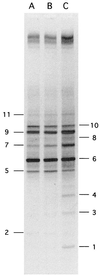Polyphasic study of the spatial distribution of microorganisms in Mexican pozol, a fermented maize dough, demonstrates the need for cultivation-independent methods to investigate traditional fermentations
- PMID: 10584005
- PMCID: PMC91745
- DOI: 10.1128/AEM.65.12.5464-5473.1999
Polyphasic study of the spatial distribution of microorganisms in Mexican pozol, a fermented maize dough, demonstrates the need for cultivation-independent methods to investigate traditional fermentations
Abstract
The distribution of microorganisms in pozol balls, a fermented maize dough, was investigated by a polyphasic approach in which we used both culture-dependent and culture-independent methods, including microbial enumeration, fermentation product analysis, quantification of microbial taxa with 16S rRNA-targeted oligonucleotide probes, determination of microbial fingerprints by denaturing gradient gel electrophoresis (DGGE), and 16S ribosomal DNA gene sequencing. Our results demonstrate that DGGE fingerprinting and rRNA quantification should allow workers to precisely and rapidly characterize the microbial assemblage in a spontaneous lactic acid fermented food. Lactic acid bacteria (LAB) accounted for 90 to 97% of the total active microflora; no streptococci were isolated, although members of the genus Streptococcus accounted for 25 to 50% of the microflora. Lactobacillus plantarum and Lactobacillus fermentum, together with members of the genera Leuconostoc and Weissella, were the other dominant organisms. The overall activity was more important at the periphery of a ball, where eucaryotes, enterobacteria, and bacterial exopolysacharide producers developed. Our results also showed that the metabolism of heterofermentative LAB was influenced in situ by the distribution of the LAB in the pozol ball, whereas homolactic fermentation was controlled primarily by sugar limitation. We propose that starch is first degraded by amylases from LAB and that the resulting sugars, together with the lactate produced, allow a secondary flora to develop in the presence of oxygen. Our results strongly suggest that cultivation-independent methods should be used to study traditional fermented foods.
Figures


References
-
- Adler-Nissen J, Demain A L. Aeration-controlled formation of acetic acid in heterolactic fermentations. J Ind Microbiol. 1994;13:335–343.
-
- Agati V, Guyot J-P, Morlon-Guyot J, Talamond P, Hounhouigan J. Isolation and characterization of new amylolytic strains of Lactobacillus fermentum from fermented maize doughs (mawè and ogi) from Benin. J Appl Microbiol. 1998;85:512–520.
-
- Akkermans ADL, Mirza M S, Harmsen H J M, Blok H J, Herron P R, Sessitsch A, Akkermans W M. Molecular ecology of microbes: a review of promises, pitfalls, and true progress. FEMS Microbiol Rev. 1994;15:185–194.
Publication types
MeSH terms
Substances
Associated data
- Actions
- Actions
- Actions
- Actions
- Actions
- Actions
- Actions
- Actions
- Actions
- Actions
- Actions
- Actions
LinkOut - more resources
Full Text Sources
Other Literature Sources
Molecular Biology Databases
Miscellaneous

